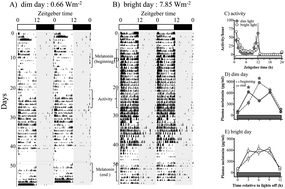Nocturnal melatonin levels decode daily light environment and reflect seasonal states in night-migratory blackheaded bunting (Emberiza melanocephala)
Abstract
We proposed two perhaps overlapping hypotheses. Hypothesis 1 examined whether daily light information was transduced by a change in the pattern of daily melatonin secretion. Hypothesis 2 tested whether the melatonin amplitude peak was contingent upon seasonal states. To test these hypotheses, we performed three experiments on night migratory blackheaded buntings (Emberiza melanocephala). The first two experiments measured plasma melatonin levels in buntings exposed to light–dark (LD) cycles, with white and/or blue (450 nm) and red (640 nm) light periods differing by about 10–12 fold in the level of illuminance. In birds exposed to a 12 h day (white light) at 0.66 W m−2 (dim) and 7.85 W m−2 (bright) light intensities (experiment 1), night melatonin levels were significantly affected by the end of 8-week exposure in the dim, not bright, day with buntings showing a bimodal nocturnal melatonin peak. Similarly, in birds on 13 h days in white, blue and red light periods at 0.028 W m−2 (dim) and 0.28 (bright) W m−2 intensities (experiment 2), mid night melatonin levels were significantly higher in red than in the blue or white light periods after 4.5 weeks of exposure. The third experiment measured plasma melatonin levels in buntings that were held under natural light conditions (NDL, 27°N; experiment 3A), or exposed to LD cycles (experiment 3B). There were slightly more elevated melatonin levels early at night during the spring (photosensitive) than during the autumn (photorefractory) migration season, without a difference in nocturnal melatonin peak between these two times providing almost similar light hours. Similarly, there was no difference in mid night melatonin levels between photosensitive and photorefractory buntings subjected to a skeleton photoperiod (1L : 11D : 1L : 11D), although melatonin levels were higher in the first than in the second 11 h dark phase in photosensitive birds. Overall, these results show that (i) nocturnal melatonin levels decode the intensity and wavelength of the daily light environment, and (ii) the daily melatonin secretion pattern subtly reflects seasonal states in the migratory blackheaded bunting.


 Please wait while we load your content...
Please wait while we load your content...